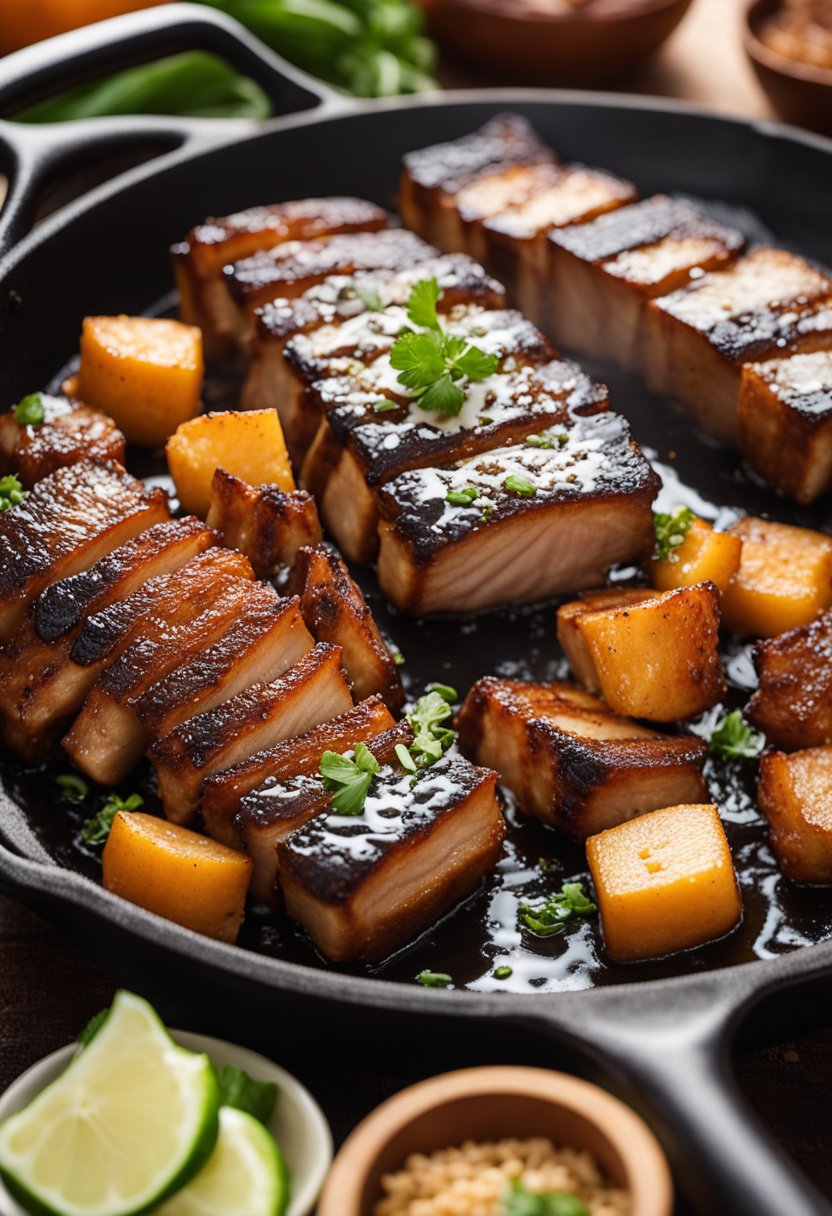Pork belly is a versatile cut of meat that can be used in a variety of dishes. From crispy bacon to succulent braised pork, there are endless possibilities when it comes to cooking with this flavorful ingredient. Pork belly recipes have become increasingly popular in recent years, with chefs and home cooks alike experimenting with different techniques and flavors.
Table of Contents
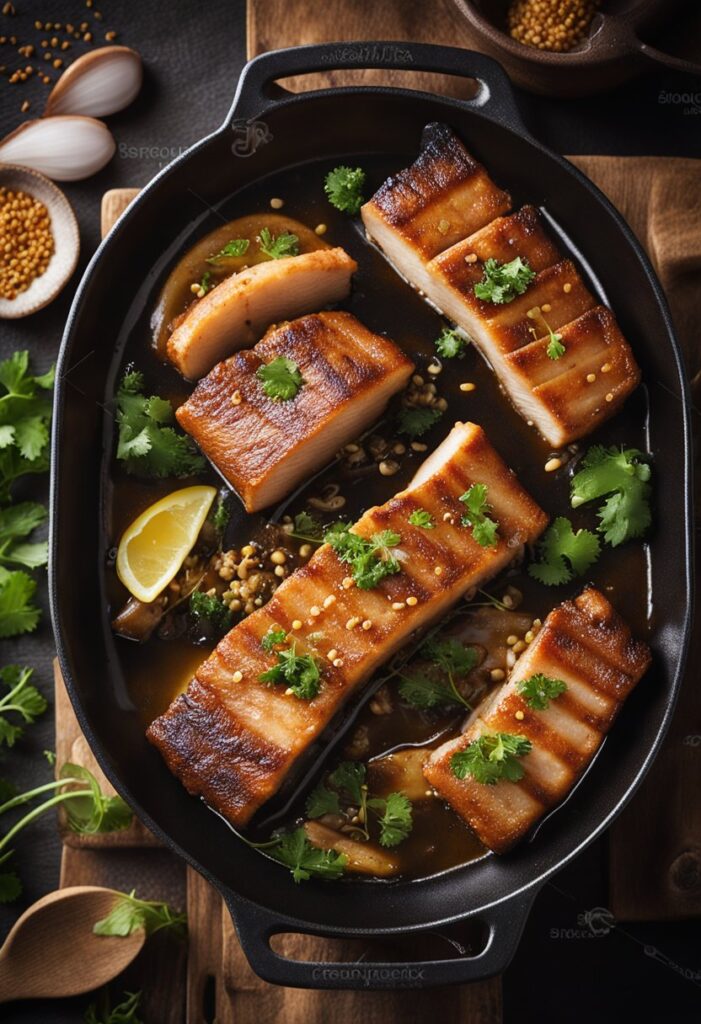
One of the most popular ways to prepare pork belly is by roasting it until it is crispy and caramelized on the outside, while still tender and juicy on the inside. This can be achieved by rubbing the pork belly with a mixture of salt, sugar, and spices, and then slow-roasting it in the oven for several hours. The result is a deliciously crispy and flavorful dish that can be served on its own or used as a base for other recipes.
Another popular way to prepare pork belly is by braising it in a flavorful liquid, such as soy sauce, vinegar, and aromatics. This method results in a tender and succulent dish that is perfect for serving with rice, noodles, or vegetables. Pork belly can also be used to make delicious sandwiches, tacos, and other dishes, making it a versatile ingredient that can be used in a variety of cuisines.
History of Pork Belly
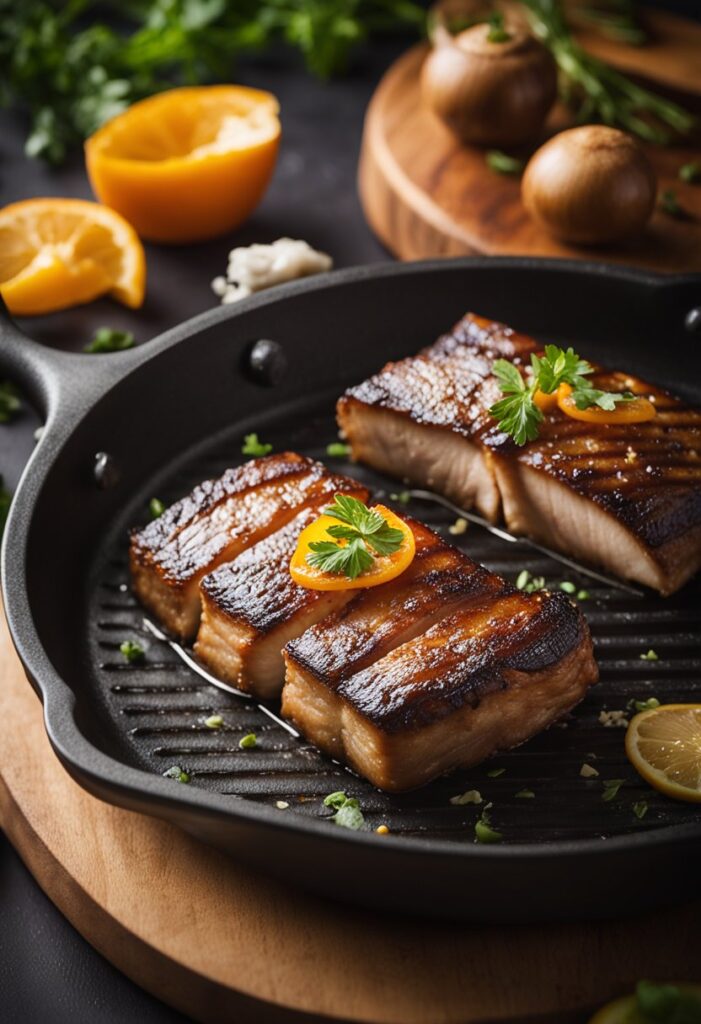
Cultural Significance
Pork belly is a popular ingredient in many cultures around the world. In Chinese cuisine, it is a staple ingredient used in many dishes, including the famous red-cooked pork belly. In Korean cuisine, pork belly is used to make samgyeopsal, a popular grilled meat dish. In the United States, pork belly is commonly used to make bacon.
The cultural significance of pork belly can be traced back to ancient times. In China, pork was considered a symbol of wealth and prosperity, and pork belly was a prized cut of meat. In Korea, pork belly was traditionally served during important celebrations, such as weddings and New Year’s Day.
Global Variations
Pork belly is prepared and served in many different ways around the world. In Japan, it is used to make chashu, a popular topping for ramen. In Germany, it is used to make schlachtplatte, a traditional pork dish. In Italy, pork belly is used to make pancetta, a type of cured meat.
Different regions also have their own unique ways of preparing pork belly. In China, red-cooked pork belly is a popular dish that is braised in soy sauce, sugar, and spices. In Korea, samgyeopsal is grilled and served with a variety of side dishes, including kimchi and rice. In the United States, bacon is often served as a breakfast food or used as a topping for burgers and sandwiches.
Overall, pork belly has a rich history and cultural significance in many parts of the world. Its versatility and unique flavor make it a popular ingredient in a variety of dishes.
Selecting Quality Pork Belly
Understanding Pork Grades
When selecting pork belly, it’s important to understand the grading system used by the USDA. The grades are based on the amount of marbling in the meat, which affects its tenderness and flavor. The three grades of pork are:
- USDA Prime: This is the highest grade of pork and is typically only available through specialty butchers or online retailers. It has the most marbling and is the most tender and flavorful.
- USDA Choice: This is the most common grade of pork and is available at most grocery stores. It has a moderate amount of marbling and is still tender and flavorful.
- USDA Select: This is the lowest grade of pork and has the least amount of marbling. It is still a good choice for some recipes, but may not be as tender or flavorful as higher grades.
When selecting pork belly, look for cuts with a good amount of marbling throughout the meat. This will ensure that the pork is tender and flavorful when cooked.
Where to Purchase
Pork belly can be purchased at most grocery stores, but for the best selection and quality, it’s recommended to purchase from a specialty butcher or online retailer. These sources often carry higher grades of pork and can provide more information about the specific cut of meat.
When purchasing from a butcher or online retailer, ask about the source of the pork. It’s important to choose pork that is raised without antibiotics and hormones and is fed a natural diet. This not only ensures a healthier product, but also a better tasting one.
Overall, selecting quality pork belly is key to creating delicious pork belly recipes. Take the time to understand the grading system and choose a reputable source for the best results.
Preparation Techniques
Trimming and Cutting
Before cooking pork belly, it is important to trim and cut it properly. Trimming helps to remove any excess fat or skin, while cutting ensures even cooking. To trim the pork belly, use a sharp knife to remove any skin or fat that is not needed. Then, cut the pork belly into even slices or cubes, depending on the recipe.
Curing and Brining
Curing and brining are two techniques that can be used to enhance the flavor and texture of pork belly. Curing involves rubbing the pork belly with a mixture of salt, sugar, and spices and letting it sit in the refrigerator for a few days. This process helps to preserve the meat and add flavor. Brining, on the other hand, involves soaking the pork belly in a saltwater solution for several hours. This technique helps to tenderize the meat and infuse it with flavor.
Marinating
Marinating is another technique that can be used to add flavor to pork belly. To marinate the pork belly, mix together your desired ingredients, such as soy sauce, garlic, and ginger, and let the pork belly sit in the mixture for a few hours or overnight. This technique helps to infuse the meat with flavor and can also help to tenderize it.
Overall, proper preparation techniques are key to achieving delicious and flavorful pork belly dishes. By trimming and cutting the pork belly properly, as well as utilizing techniques such as curing, brining, and marinating, you can elevate the taste and texture of this versatile cut of meat.
Cooking Methods
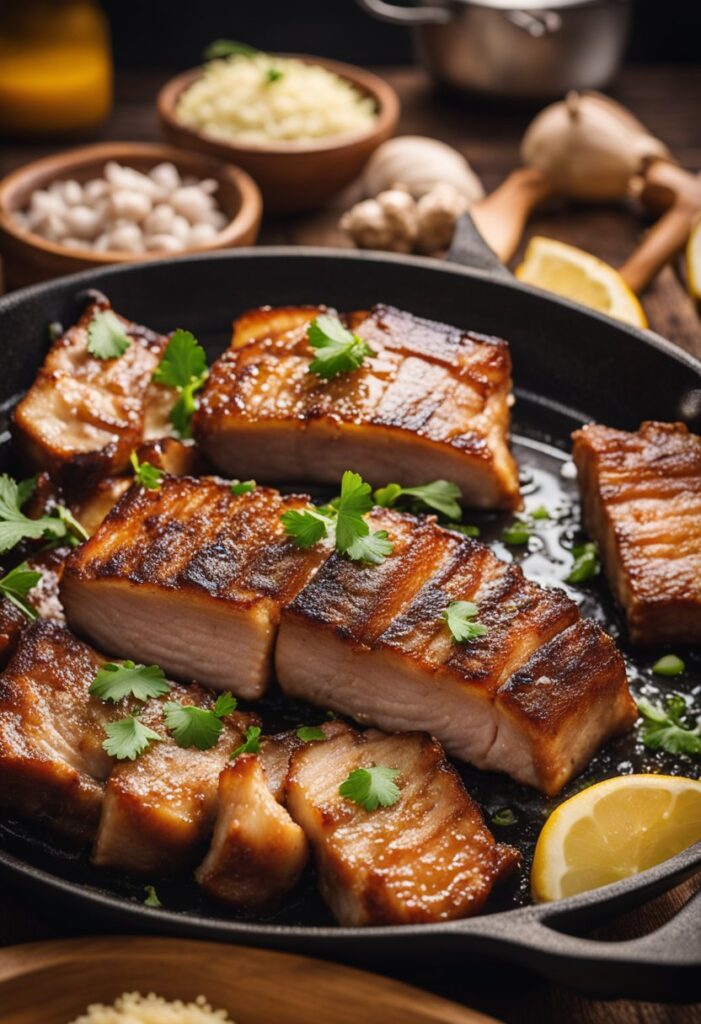
Roasting
Roasting is a popular method for cooking pork belly. This method involves placing the pork belly in a preheated oven and cooking it until it is crispy on the outside and tender on the inside. To achieve this, it is recommended to score the skin before roasting to allow the fat to render out and the skin to crisp up.
Braising
Braising is another popular method for cooking pork belly. This method involves cooking the pork belly in a liquid, such as broth or wine, over low heat for an extended period of time. This results in a tender and flavorful meat. It is recommended to sear the pork belly before braising to add flavor and texture.
Grilling
Grilling pork belly is a great way to add a smoky flavor to the meat. It is recommended to marinate the pork belly in a flavorful mixture before grilling to enhance the taste. It is also important to cook the pork belly on low heat to prevent it from drying out.
Sous Vide
Sous vide is a cooking method that involves vacuum-sealing the pork belly and cooking it in a water bath at a precise temperature for an extended period of time. This method results in a perfectly cooked and tender meat. It is recommended to sear the pork belly after cooking to add flavor and texture.
Overall, there are several cooking methods that can be used to prepare delicious pork belly dishes. Each method has its own unique advantages and can produce amazing results when done correctly.
Classic Pork Belly Recipes
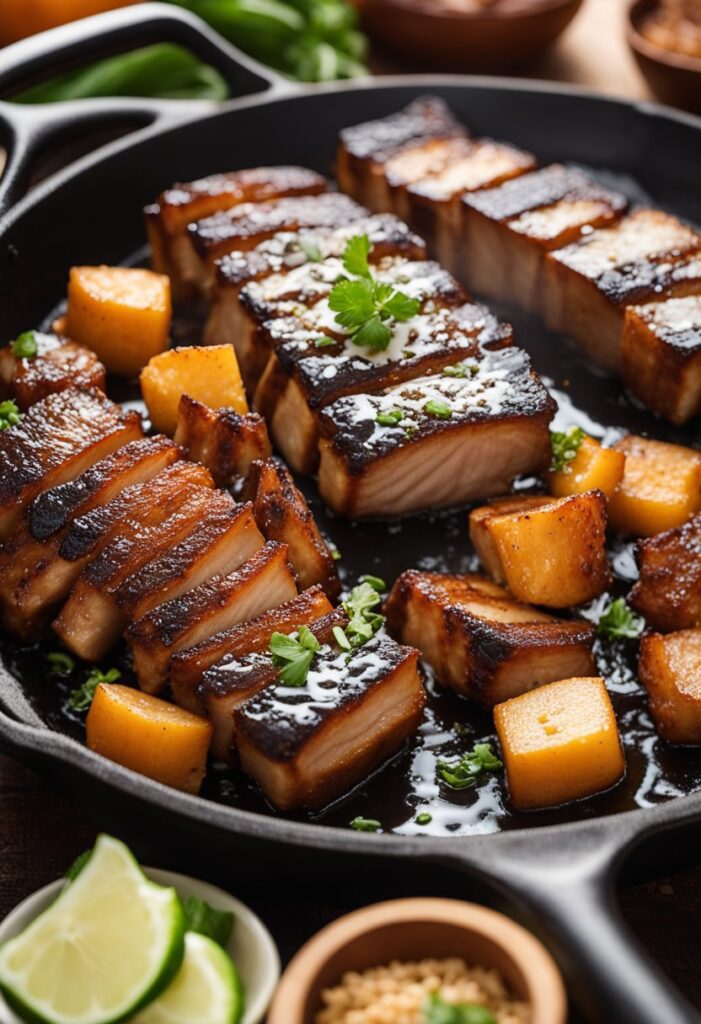
Crispy Skin Pork Belly
Crispy skin pork belly is a classic dish that is loved by many. The key to achieving the perfect crispy skin is to dry the skin thoroughly and score it before cooking. Rubbing salt and oil on the skin will also help to achieve a crispy texture.
One popular recipe for crispy skin pork belly involves marinating the pork belly in a mixture of soy sauce, sugar, garlic, and ginger before roasting it in the oven. The result is a deliciously crispy and flavorful dish that is perfect for any occasion.
Slow-Cooked Pork Belly
Slow-cooked pork belly is another classic recipe that is perfect for those who love tender and juicy meat. This dish involves cooking the pork belly at a low temperature for several hours to allow the meat to become tender and flavorful.
One popular recipe for slow-cooked pork belly involves marinating the pork belly in a mixture of soy sauce, hoisin sauce, honey, and Chinese five-spice powder before slow-cooking it in the oven. The result is a melt-in-your-mouth dish that is perfect for a cozy night in.
Pork Belly Buns
Pork belly buns are a popular street food in many Asian countries and are loved for their soft and fluffy buns and flavorful pork belly filling. The pork belly is typically slow-cooked with a mixture of soy sauce, sugar, and spices before being sliced and served in a steamed bun.
To make pork belly buns at home, you can use store-bought buns or make your own from scratch. Fill the buns with sliced pork belly, fresh herbs, and a drizzle of hoisin sauce for a delicious and satisfying meal.
Overall, these classic pork belly recipes are perfect for those who love flavorful and satisfying dishes. Whether you prefer crispy skin or tender meat, there is a recipe for everyone to enjoy.
Modern Twists on Traditional Recipes
Fusion Pork Belly Dishes
Looking for a way to spice up your pork belly recipe? Look no further than fusion dishes that blend traditional recipes with flavors from around the world. For example, try a Korean-inspired pork belly tacos recipe that uses gochujang sauce and kimchi slaw for a spicy and tangy twist on the classic taco. Or, try a Vietnamese-inspired pork belly banh mi sandwich that uses pickled vegetables and cilantro for a fresh and flavorful bite.
Another option is to incorporate Middle Eastern flavors into your pork belly dish. A Moroccan-inspired pork belly tagine recipe uses spices like cumin and coriander for a warm and fragrant dish. Or, try a Lebanese-inspired pork belly shawarma recipe that uses a yogurt-based sauce and fresh herbs for a cool and refreshing flavor.
Vegetarian-Inspired Sides
While pork belly is often the star of the show, don’t forget about the sides! For a vegetarian twist on traditional pork belly recipes, try incorporating flavorful vegetable dishes as sides. For example, a roasted Brussels sprouts recipe with a balsamic glaze adds a sweet and tangy complement to the rich and savory pork belly. Or, try a creamy polenta recipe with roasted mushrooms for a hearty and satisfying side dish.
For a lighter option, try a fresh and crunchy Asian-inspired slaw with carrots, cabbage, and a sesame dressing. Or, try a simple roasted sweet potato recipe with a sprinkle of cinnamon for a sweet and savory pairing with the pork belly.
By incorporating these modern twists on traditional pork belly recipes, you can elevate your dish to a whole new level of flavor and excitement.
Serving and Presentation
Plating Techniques
When it comes to plating pork belly, there are a few techniques that can elevate the presentation of the dish. One popular technique is to slice the pork belly into thin, even pieces and arrange them in a fan shape on the plate. Another option is to stack the slices on top of each other, creating a tower of crispy pork belly. For a more rustic presentation, consider serving the pork belly on a wooden board or slate slab.
Accompaniments and Pairings
To balance out the richness of the pork belly, consider serving it with a variety of accompaniments and pairings. A simple green salad with a light vinaigrette can provide a refreshing contrast to the fatty pork belly. Roasted or grilled vegetables, such as asparagus or Brussels sprouts, can add a savory note to the dish. For a more indulgent pairing, consider serving the pork belly with mashed potatoes or creamy polenta.
When it comes to beverages, a full-bodied red wine, such as a Cabernet Sauvignon or Syrah, can complement the richness of the pork belly. For beer lovers, a dark ale or stout can provide a similar effect. Alternatively, a crisp, acidic white wine, such as a Sauvignon Blanc or Pinot Grigio, can provide a refreshing contrast to the pork belly.
Nutritional Information
Caloric Content
Pork belly is a high-calorie food, with approximately 500 calories per 100 grams. It is a rich source of fat, which contributes to its high caloric content. However, not all fats are created equal. Pork belly contains both saturated and unsaturated fats, with the latter being considered healthier.
Health Considerations
Consuming pork belly in moderation can be a part of a healthy diet. It is an excellent source of protein, vitamin B12, and zinc. However, excessive consumption may increase the risk of heart disease, due to its high saturated fat content.
It is important to note that the nutritional content of pork belly can vary depending on how it is prepared. For example, frying pork belly will increase its fat content and caloric value. On the other hand, baking or grilling it can reduce its fat content and caloric value.
In conclusion, pork belly can be a delicious addition to a balanced diet when consumed in moderation and prepared in a healthy way. It is important to be mindful of portion sizes and cooking methods to ensure that it is enjoyed as a part of a healthy lifestyle.
Storage and Leftovers
Refrigeration and Freezing
Pork belly can be stored in the refrigerator for up to 4 days, but it is best to consume it within 2-3 days to ensure freshness. To store pork belly, wrap it tightly in plastic wrap or aluminum foil and place it in an airtight container or resealable plastic bag.
If you want to store pork belly for a longer period, you can freeze it. Wrap the pork belly tightly in plastic wrap or aluminum foil, and then place it in a resealable plastic bag. Make sure to label the bag with the date so you can keep track of how long it has been frozen. Pork belly can be stored in the freezer for up to 6 months.
Before using frozen pork belly, it should be thawed in the refrigerator overnight. Do not thaw pork belly at room temperature, as this can increase the risk of bacterial growth.
Reheating Tips
To reheat pork belly, place it in a preheated oven at 350°F for 10-15 minutes, or until it is heated through. You can also reheat pork belly in a skillet over medium heat, stirring occasionally, until it is heated through.
When reheating pork belly, make sure it reaches an internal temperature of 165°F to ensure that it is safe to eat. Avoid reheating pork belly in the microwave, as this can cause it to become rubbery.
Overall, pork belly is a delicious and versatile ingredient that can be enjoyed in a variety of dishes. By following these storage and reheating tips, you can ensure that your pork belly stays fresh and delicious, even when stored as leftovers.

